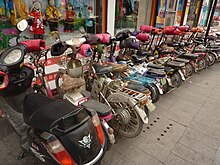|
Cycling glove
Cycling gloves are gloves designed for cycling. They may provide warmth, comfort and protection.  Basic functionalityWarmth Gloves are frequently used to keep the hands warm, a function that is particularly necessary when cycling in cold weather. The design of most modern bicycles is such that the rider's hands remain on the handlebars while cycling, a position that leaves them exposed to weather. The hands are also relatively inactive, and do not have a great deal of muscle mass, which also contributes to the possibility of chill. Gloves are therefore vital for insulating the hands from cold, wind, and evaporative cooling while riding a bicycle. GripIn warm weather, sweat from cyclists' hands can cause difficulty maintaining control over the bicycle by making handlebars slippery and difficult to hold without increased hand tension (which can cause further issues and numbness). Cycling gloves, some designed without full finger covering and with ventilation to reduce temperature (the opposite intention of cold weather gloves) are used to increase grip and prevent sweat from making handlebars slippery. ComfortCycling places a good deal of stress on the hands, in the form of prolonged pressure against handlebars and transmission of sudden road shocks through handlebars to the hands. The severity of discomfort can be mitigated somewhat by riding position, but is essentially inherent in most designs of upright bicycle. However, choice of weight distribution between the saddle and handlebars is usually determined by other factors, such as aerodynamics, control and long-term comfort. Padded gloves or handlebar grips are therefore useful to increase comfort for a given geometry. However, excess padding can lead to other problems. Normally the hands will rest on the bones in the heel of the hand - too much padding will tend to press on the soft tissues between these and can compress the nerves in the hands, causing something akin to carpal tunnel syndrome. Face and nose wipingCyclists often deal with perspiration and nose running on a constant basis. Because clothes and paper tissues may be difficult and time-consuming to use during cycling, many cyclists have resorted to using the backs of their gloves to wipe the sweat from their faces and the nasal mucus that drips from their noses. Many modern cycling gloves come with a built in "nose wipe" on the back of the hand, typically on the thumb or forefinger or both. Aftermarket fabric nose wipes that slip onto the back of the hand or wrist of the glove are also preferred by some cyclists. ProtectionPutting a hand out to break a fall is a natural reaction. However, the hands are one of the more difficult parts of the body to repair. There is little or no spare skin, and immobilising the hands sufficiently to promote healing involves significant inconvenience to the patient. So, many cyclists choose to wear gloves all year round to help avoid skin damage in a fall. Types of gloves
Care of glovesSweat from hands can make one's gloves become unpleasant quite quickly, so it is best to store them so that air can circulate inside if at all possible (for example on a radiator). After a wet or hard ride it may be best to turn them inside-out to dry. Leather gloves can be washed in cool water and are reportedly best dried out on the hands. See alsoReferences |
Portal di Ensiklopedia Dunia